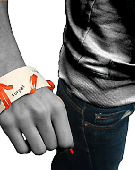Dec 15, 2006
Intelligent rooms: RoomRender
Via Pink Tentacle

SGI Japan has developed a system that can control the electronics, appliances and hardware in a room based on the spoken commands and emotions of the room’s occupants. RoomRender relies on AmiVoice voice recognition technology (developed by Advanced Media) to recognize and analyze spoken commands, enabling the room to close the blinds, turn on the heater, etc. as instructed.
Read the full story on Pink Tentacle
00:11 Posted in Pervasive computing | Permalink | Comments (0) | Tags: ambient intelligence, emotional computing, pervasive technology, persuasive technology
Oct 01, 2006
SCACS
Re-blogged from information aesthetic

SCACS is a "Social Context-Aware Communication System" that collects information on social networks (i.e. academic co-author relationships networks) & visualizes them on wearable interfaces to facilitate face-to-face communications among people in physical environments. RFID sensors sense the identity of specific people (i.e. authors) nearby, & a wearable computer transforms the complex social network graphs into treemaps, which are then shown as augmented reality on a wearable interface (or head-mounted display).
link: aist-nara.ac.jp (pdf)
12:51 Posted in Augmented/mixed reality, Wearable & mobile | Permalink | Comments (0) | Tags: pervasive technology, augmented reality, mobile computing
Sep 30, 2006
Perimeters, Boundaries, and Borders
|
Artists, architects, designers, and other practitioners are constantly fashioning new forms and challenging disciplinary boundaries as they employ techniques such as rapid prototyping and generative processes. In the exhibition Perimeters, Boundaries, and Borders, at Lancaster, UK's Citylab, organizers Fast-uk and Folly explore the range of objects, buildings, and products being conceptualized with the aid of digital technologies. Aoife Ludlow's 'Remember to Forget?' is a series of jewelry designs that envisioned accessories incorporating RFID tags that allow the wearer to record information and emotions associated with those special items that we put on daily. Tavs Jorgensen uses a data glove in his 'Motion in Form' project. After gesturing around an object, data collected by the glove is given physical shape using CNC (Computer Numerical Control) milling, creating representations of the movements in materials such as glass or ceramics. Addressing traces of a different sort is Cylcone.soc, a data mapping piece by Gavin Bailey and Tom Corby. These works and many more examples from the frontiers of art and design are on view until October 21st." Rhizome News. |
19:39 Posted in Emotional computing, Pervasive computing | Permalink | Comments (0) | Tags: ambient intelligence, emotional computing, pervasive technology, persuasive technology
Sep 24, 2006
Is social networking changing the way people relate to each other?
New Scientist has an interview with sociologist and MIT professor Sherry Turkle about how "always-on" communication devices - i.e. instant messaging, Wi-Fi and cellphones - are changing the way people relate to each other.
Here is an excerpt from the article:
For some people, things move from "I have a feeling, I want to call a friend" to "I want to feel something, I need to make a call". In either case, what is not being cultivated is the ability to be alone and to manage and contain one's emotions. When technology brings us to the point where we're used to sharing our thoughts and feelings instantaneously, it can lead to a new dependence, sometimes to the extent that we need others in order to feel our feelings in the first place.
Our new intimacies with our machines create a world where it makes sense to speak of a new state of the self. When someone says "I am on my cell", "online", "on instant messaging" or "on the web", these phrases suggest a new placement of the subject, a subject wired into social existence through technology, a tethered self. I think of tethering as the way we connect to always-on communication devices and to the people and things we reach through them.
Continue to read the full interview
21:30 Posted in Persuasive technology, Pervasive computing | Permalink | Comments (0) | Tags: pervasive technology







